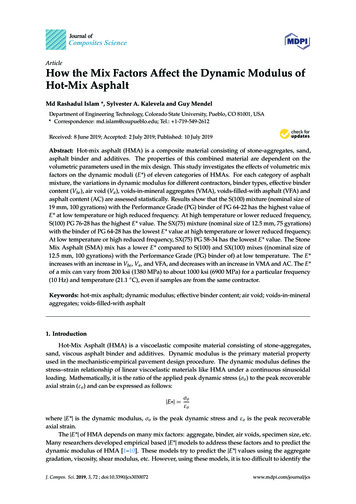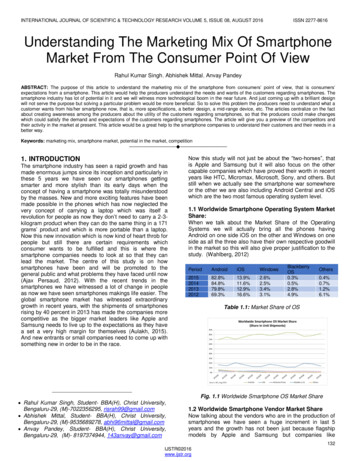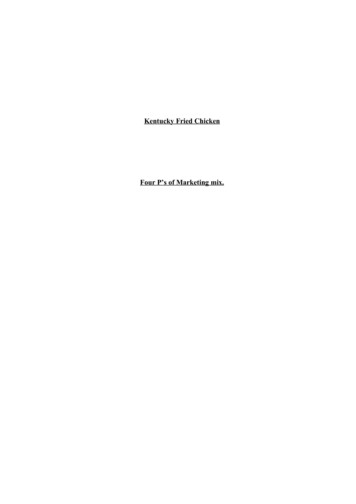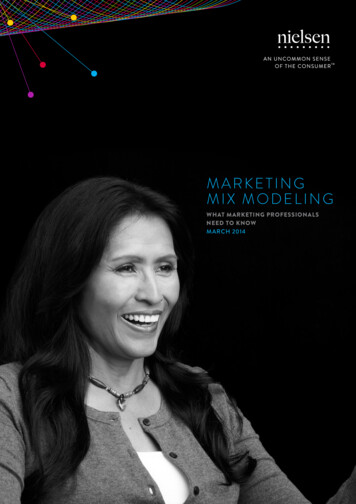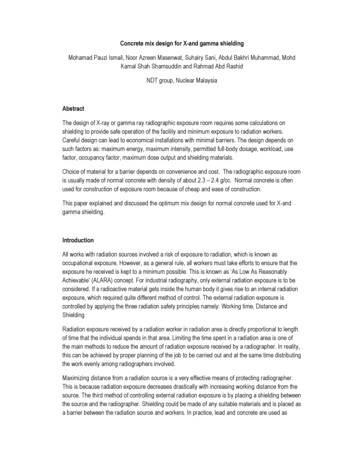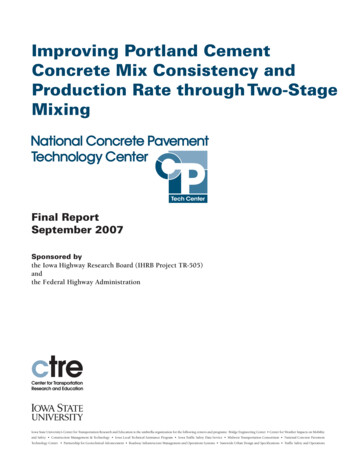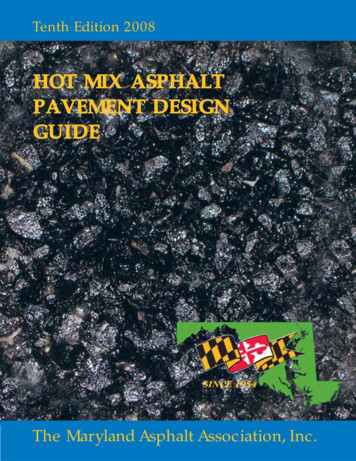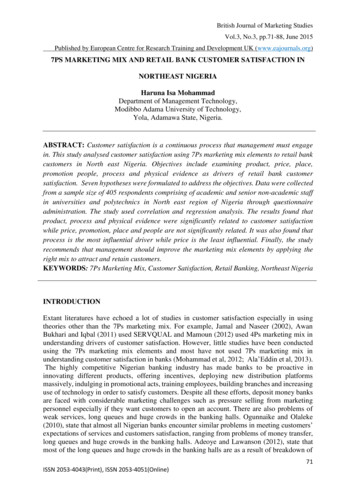
Transcription
British Journal of Marketing StudiesVol.3, No.3, pp.71-88, June 2015Published by European Centre for Research Training and Development UK (www.eajournals.org)7PS MARKETING MIX AND RETAIL BANK CUSTOMER SATISFACTION INNORTHEAST NIGERIAHaruna Isa MohammadDepartment of Management Technology,Modibbo Adama University of Technology,Yola, Adamawa State, Nigeria.ABSTRACT: Customer satisfaction is a continuous process that management must engagein. This study analysed customer satisfaction using 7Ps marketing mix elements to retail bankcustomers in North east Nigeria. Objectives include examining product, price, place,promotion people, process and physical evidence as drivers of retail bank customersatisfaction. Seven hypotheses were formulated to address the objectives. Data were collectedfrom a sample size of 405 respondents comprising of academic and senior non-academic staffin universities and polytechnics in North east region of Nigeria through questionnaireadministration. The study used correlation and regression analysis. The results found thatproduct, process and physical evidence were significantly related to customer satisfactionwhile price, promotion, place and people are not significantly related. It was also found thatprocess is the most influential driver while price is the least influential. Finally, the studyrecommends that management should improve the marketing mix elements by applying theright mix to attract and retain customers.KEYWORDS: 7Ps Marketing Mix, Customer Satisfaction, Retail Banking, Northeast NigeriaINTRODUCTIONExtant literatures have echoed a lot of studies in customer satisfaction especially in usingtheories other than the 7Ps marketing mix. For example, Jamal and Naseer (2002), AwanBukhari and Iqbal (2011) used SERVQUAL and Mamoun (2012) used 4Ps marketing mix inunderstanding drivers of customer satisfaction. However, little studies have been conductedusing the 7Ps marketing mix elements and most have not used 7Ps marketing mix inunderstanding customer satisfaction in banks (Mohammad et al, 2012; Ala’Eddin et al, 2013).The highly competitive Nigerian banking industry has made banks to be proactive ininnovating different products, offering incentives, deploying new distribution platformsmassively, indulging in promotional acts, training employees, building branches and increasinguse of technology in order to satisfy customers. Despite all these efforts, deposit money banksare faced with considerable marketing challenges such as pressure selling from marketingpersonnel especially if they want customers to open an account. There are also problems ofweak services, long queues and huge crowds in the banking halls. Ogunnaike and Olaleke(2010), state that almost all Nigerian banks encounter similar problems in meeting customers’expectations of services and customers satisfaction, ranging from problems of money transfer,long queues and huge crowds in the banking halls. Adeoye and Lawanson (2012), state thatmost of the long queues and huge crowds in the banking halls are as a result of breakdown of71ISSN 2053-4043(Print), ISSN 2053-4051(Online)
British Journal of Marketing StudiesVol.3, No.3, pp.71-88, June 2015Published by European Centre for Research Training and Development UK (www.eajournals.org)computers and at times as a result of cashiers absconding from duty and passing the bulk tosomeone else. Therefore, this study seeks to understand the impact of 7Ps marketing mixelements on retail customer satisfaction of deposit money banks in Nigeria.Objectives of the Study1.To assess the relationship between 7Ps marketing mix and bank customer satisfactionin Northeast Nigeria.2.To determine the strongest and the weakest drivers of bank customer satisfaction amongthe 7Ps in Northeast Nigeria.LITERATURE REVIEW AND HYPOTHESES DEVELOPMENTOne of the main areas focused on by organisations today is how to satisfy customers, becauseof the organizational benefit of customer satisfaction. Customer satisfaction is linked tocustomer loyalty (Fornell, 1992). Customer satisfaction is also associated with building andmaintaining strong customer relationship (Blattberg, et al, 2009). Customer satisfaction can beviewed as a relationship of perceived value of service and the expected value by customers. Ifthe perceived value of services matches customer perceived expected value, then customer issaid to be satisfied. Kotler and Armstrong (2013: P37) define customer satisfaction as “theextent to which a product’s perceived performance matches a buyer’s expectation.” Marketingmix elements are means to an end, they pave way for marketing managers to achieveorganizational goals and objectives through proper planning. McCarthy and Perreault (1987)defined marketing mix as controllable variables used by organisations to satisfy target market.Kotler and Armstrong (1989:P45) define marketing mix as “the set of controllable marketingvariables that the firm blends to produce the response of wants in the target market.” The twodefinitions above are closely related. They both agreed marketing mix are controllable toolsthat should be used towards satisfying target market. The major disagreement in literature iswhat consists of controllable variables or tools as pointed by Rafiq and Ahmed (1995). The4Ps marketing mix of McCarthy (1964) has received considerable criticism from literaturesespecially from service areas (See Robins, 1991; Davies, 1997; Mulhern, 1997;andKotler,2003). Booms and Bitner (1981) extended the 4Ps framework to include process,physical evidence and participants, to reflect service industry. The extension of the 4Ps byBooms and Bitner has gained wide acceptance (Rafiq and Ahmed, 1995).ServiceProduct/ service define the core offering of a business. In banking industry, managers muststrive to satisfy customers as customers are after value and benefits. Kotler and Armstrong(2013) define product as anything tangible or intangible offered to a market for attention, useand consumption with aim of satisfying needs and wants of customers. In this definition, theyconsider product to include services. Products in banks includes different accounts forcustomers to use for example current accounts, savings accounts, save for children, otherproducts are investment advice, loans and agenciesResearches have established relation between product and customer satisfaction. For example,Alhemoud (2010) studied the determinants of customer satisfaction in Kuwait retail banks,using 605 randomly distributed questionnaire to both citizen and non-citizen residents ofKuwait. He found customers are generally satisfied with the service quality provided by Kuwaitbanks.72ISSN 2053-4043(Print), ISSN 2053-4051(Online)
British Journal of Marketing StudiesVol.3, No.3, pp.71-88, June 2015Published by European Centre for Research Training and Development UK (www.eajournals.org)Mammon (2012) indicated that among marketing mix elements, product significantlyinfluences customer satisfaction. Addo & Kwarteng (2012) assess the determinants of customersatisfaction and the level of acceptability of services provided by private banks in Ghana, usingthe service quality dimension. They surveyed 140 respondents for their perception about thefive dimensions of service quality as regards their banks. They analysed the data usingdescriptive statistics, factor analysis and correlation. Their result indicates all five dimensionsof service quality are significant predictors of customer satisfaction in retail banks in Ghana.Flowing from the results/conclusions of the studies above, one of the ways banks can increasemarket share is through having viable products. Banks must encourage customers to openaccount and increase the service quality with different product innovation in order to achievecompetitive advantage. Therefore, the relationship between service and customer satisfactionhas been established.H01: There is no significant relationship between service and bank customer satisfaction inNortheast Nigeria.PricePrice is one of the ways marketers communicate with customers. Price is seen as revenueoriented been the only marketing mix element that produces revenue. Winkler (1995:439)defined price “as the amount of money which is sacrificed to obtain something”. Varki &Colgate (2001) studied customer perceptions of value (Price) in the banking industry in the U.S. and New Zealand. The authors’ result showed that value (price) perceptions directlyinfluence customer satisfaction. Leverin & LiLjander (2006) suggest that bank customersatisfaction is influenced by factors such as the price of services, or the number and severity ofnegative critical incidents. A study by Leversques & McDogall (1996) revealed that bankcharges and interest rates determined the overall satisfaction level of customers. However,Nasser, Jamal & Al-Khatib (1999) and Chen & Chang (2005) suggest value (price) is perceivedto have a small impact on bank customer satisfaction, but should not be neglected since valueplays a role in enhancing the level of customer satisfaction in retail banking. Therefore, therelationship between price and customer satisfaction has been established.H02: There is no significant relationship between price and bank customer satisfaction inNortheast Nigeria.PlacePlace which is also called distribution, is consider to cover distributional activities oforganisations. Kotler (1976) indicates that distribution involves the distribution channel,distribution coverage, outlet locations, inventory levels and location. In banks in Nigeriadistribution involves the internet banking, telephone banking, human teller, ATM and so on.Related studies have shown that elements of distribution like internet banking, AutomatedTeller Machines, bank branches, etc. influence customer satisfaction .In the banking sector,Nmako, et al, (2013), investigated customer satisfaction with internet banking service qualityin the Ghanaian banking industry. They found that customers of Merchant Bank of Ghana(MBG) are more satisfied with internet banking service quality than those of GhanaCommercial bank (GCB). Mwatsika (2014) investigated customer satisfaction with ATMbanking in Malawi. The empirical findings indicated customer satisfaction with ATM. Lenka,et al, (2009), conducted research on services quality and customer loyalty in Indian commercialbanks. The study revealed in what seemed a departure from the studies above that human73ISSN 2053-4043(Print), ISSN 2053-4051(Online)
British Journal of Marketing StudiesVol.3, No.3, pp.71-88, June 2015Published by European Centre for Research Training and Development UK (www.eajournals.org)aspects of service quality were found to influence customer satisfaction more than the technicaland tangible aspect. It will therefore not be out of place for management to harmonise theelements of place (distribution) to offer good satisfaction to customer. Management shouldsimplify the electronic aspect of distribution and embark on high orientation for customers.Mohammad, et al, (2012), conducted research on impact of marketing mix elements on touristsatisfaction on East Lake. Similarly, Duhaime (1988), conducted research on customersatisfaction with distribution for durable goods, the result concludes that customers are satisfiedwith overall distribution. Therefore, the relationship between place and customer satisfactionhas been established.H03: There is no significant relationship between place and bank customer satisfaction inNortheast Nigeria.PromotionPromotion is sending a persuasive message about a particular product to customers.Mohammad et al, (2012), in their investigation of the impact of marketing mix elements ontourist satisfaction found promotion to be significantly related to customer satisfaction.Mylonakis (2009), surveyed bank customers on bank satisfaction factors and loyalty and thefindings point out that advertising (the humorous method) is generally accepted by people. ButBena (2010), in a research on evaluation of customer satisfaction in banking services, foundcustomers are dissatisfied with promotion. Management should involve in promotionalmessages that educate and enlighten customers. Bank should also use sales promotion thatgives incentives such as discounts to customers to lower cost of banking and capital. Therefore,the relationship between promotion and customer satisfaction has been established.H04: There is no significant relationship between promotion and bank customer satisfactionin Northeast Nigeria.PeoplePeople, refers to those involved in service delivery. Their level of training, interpersonalbehaviour, discretion in rendering the service and appearance matters a lot in customersatisfaction in banking industry. Thorsten (2004) opines that customer orientation of serviceemployees is a key driver of customer satisfaction. The interaction of employees and customerscreate good customer satisfaction. Customers rely on bank employees for advice, complaintand direction towards some of the banks’ products and channel of distribution. Interactionquality is an important factor when customers evaluate service quality. Ennew & Binks (1999),McDougall and Levesque (1994), and Ojusalo (2003), found out that, the interactions drivingthe service producers have important effect on customer perceptions of service quality. Siddiqi(2011), in a research on interrelations between service quality, attributes, customer satisfactionand customer loyalty in retail banking sector in Bangladesh, found that empathy (interactionbetween employees and customers) has a large positive correlation with customer satisfaction.Similarly, Ladhari (2009), in an assessment of the psychometric properties of SERVQUAL inthe Canadian banking industry, found that empathy is the strongest predictor of customersatisfaction. Mohammad et al, (2012), in a research, which investigated the impact ofmarketing mix elements on tourist satisfaction on East Lake, found evidence of significantrelation
KEYWORDS: 7Ps Marketing Mix, Customer Satisfaction, Retail Banking, Northeast Nigeria INTRODUCTION Extant literatures have echoed a lot of studies in customer satisfaction especially in using theories other than the 7Ps marketing mix. For example, Jamal and Naseer (2002), Awan Bukhari and Iqbal (2011) used SERVQUAL and Mamoun (2012) used 4Ps marketing mix in understanding
